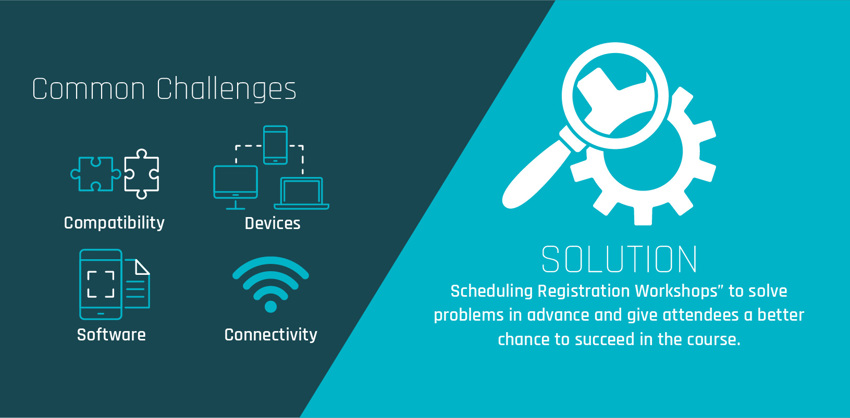Taming the Wild BOM: Why You Need a PLM System to Corral Your Data
Learn why you need a PLM system to help corral your data in our latest blog.

With the recent changes in government restrictions, all of us involved in our training business are looking forward to returning to the classroom. In fact, it’s already begun. In the last 30 days, nearly all our training centers have seen in-person courses for the first time in 18 months.
While this is an exciting change, it raises a question: where does this leave virtual training? Will customers want to abandon this format now that we are back in the classroom again?

Like many companies, our training division had to re-engineer the way we worked during the pandemic. The task? Only to create a rich, interactive, personalized learning environment where customers can quickly absorb hands-on software skills – without actually being in the same room together. Easy right? Well . . . it wasn’t easy. Here are my reflections on what we have learned about delivering Autodesk training in a virtual setting:
We know this because our customers are telling us. Since April 2020, Symetri has trained 1,500 Autodesk users virtually – in the UK alone. I have read the official feedback from every single person and I can report that across 300 different courses delivered by 24 different trainers, 97% of delegates rated the overall experience as either “satisfied” or “very satisfied,” with two-thirds giving their course the highest rating possible - in a virtual classroom!
Looking at the feedback over a similar period delivering in-person training prior to the pandemic, there is no way to tell the difference in customer satisfaction. Being in the training business for over 30 years, I personally find this remarkable. And I know, I could be making up these numbers . . . but I’m not.

Sitting and staring at a computer screen for the same amount of time as you would on a traditional course, for 2-3 days straight, doesn’t work. Virtual training works best with shorter modules and more frequent breaks – for example, 45-minute sessions followed by 15-minute breaks. And the more modular the better. Last year, we decided to deliver all virtual courses on alternate days, rather than consecutive. This means that attendees not only avoid burning out on the course, but they also get a chance to use their new skills in between sessions. So, a three-day course running Monday, Wednesday, Friday leaves Tuesday and Thursday for practice. Our trainers have also found that their virtual courses require more structure, so it’s easier for delegates to follow along remotely.

We have found that the software platform used to deliver virtual courses makes a huge difference in how attendees learn. Here are some customer quotes based on their experiences:
These are typical comments from customers about our choice of a virtual training platform. This new technology gives our trainers a chance to create an interactive, hands-on learning environment. Our experience (and testing) taught us that the commonly used webinar software wouldn’t do the job. One of our trainers who recently joined us from a competitor commented, “I can tell you that virtual training will not work unless you have the right tool to deliver it.” And I couldn’t agree more.
Most barriers to a successful virtual course revolve around IT. We are often relying on a delegate’s home setup – their connectivity, whether their computer is capable, or whether they have the right software installed. Certainly, many things can go wrong. On one project where we trained 160 Civil 3D users, we estimated that as many as 50% of those showing up for training would have been unprepared to start on time due to these issues. So, we learned early on that if we ran a 45-minute “registration workshop” the week before a course to solve these problems, we could eliminate delays and could give everyone a better chance to succeed.
Another challenge that surprised me. With virtual training, there is the added risk that attendees do not “respect” the course as much as they would an in-person training session. You would never have a delegate get up in the middle of a course at a training center and say, “Excuse me, but I have to leave for an hour for an important meeting.” With a virtual course, that can happen. We learned that it’s best if the course organizer deals with this up front, setting expectations of full attendance for the entire course.

Training in person has its difficulties, for example, it would be challenging for an instructor in Portsmouth to co-teach with a trainer in Gothenburg for a group of six Civil Engineers in Glasgow. (Yes, how cool is that? This was one of our first virtual courses last year.) Or for a woman on maternity leave to attend a Revit training course with her baby sitting on her knee for most of the time. Or a woman in California to attend one of our Civil 3D training courses. Or for a company with people in each of their Bristol, London, and Edinburgh offices to organize a single course on the same dates for all to attend.
The past 18 months saw all these examples, and many, many more, where the flexibility of virtual training opened new doors for our customers. We also discovered that infrequently run courses – particularly advanced ones -- are more likely to happen when we are drawing interest across geographic boundaries. The location of the training center no longer matters. In fact, in our manufacturing group, our Nastran course replaced Inventor Essentials as our most popular course over the past 18 months.

There are some strong feelings out there against virtual training, for whatever reason. Some may have had a bad online training experience, or others may feel that it’s “just not training.” These attitudes are a shame, of course – particularly after reading the feedback from 1,500 different individuals. For the vast majority, our course was their first virtual training experience. They had no idea what to expect and many said they were skeptical. I noted that only 12 commented that they wished their course was conducted in person, which means you would have to talk to 125 people before you found one who thought the experience fell short of the mark. Which, again, I think is remarkable. But for those who will not consider virtual training, it’s okay as we’re back in the classroom now too.

Now this is the biggest surprise of all for me. I expected to read how many appreciated the opportunity to attend training virtually, as it was the only option available during lock down. Several commented on the green benefits, allowing them to reduce their carbon footprint, etc. But what was a real surprise was how many actually preferred virtual training from a learning standpoint. People liked having the instructor’s screen side-by-side to their second screen, which was running their application. Others liked all the virtual classroom tools, finding it easier to interact and learn. Still others commented on how they could absorb information better and quicker in this setting. People actually preferring a virtual classroom to a physical one? Now that’s unexpected.
I think around about now, many in the training business will be rushing back to the classroom, abandoning virtual training as a bad idea, thinking “Phew, I’m glad that’s over!” From my standpoint, virtual training is here to stay. Time will tell, of course. Perhaps in a year’s time we will find ourselves delivering 50% of all courses virtually, maybe more. But if the feedback from our customers is anything to go by, a growing percentage are going “all in” on virtual training, and why not? Virtual training means lower costs, greater flexibility, it’s more sustainable and it delivers great learning outcomes. As one customer put it, “I think this is the future of training.” Well, certainly part of it, I am sure.
Learn why you need a PLM system to help corral your data in our latest blog.
Learn about BIM to GIS Collaboration Patterns Between Owners, AEC Firms, and Municipalities in our most recent blog post.
Learn about the Dynamic Duo of Water Infrastructure Management through Autodesk’s InfoWater Pro and Esri ArcGIS in our most recent blog post.
